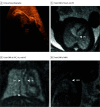Utility of Fetal Cardiovascular Magnetic Resonance for Prenatal Diagnosis of Complex Congenital Heart Defects
- PMID: 33779747
- PMCID: PMC8008290
- DOI: 10.1001/jamanetworkopen.2021.3538
Utility of Fetal Cardiovascular Magnetic Resonance for Prenatal Diagnosis of Complex Congenital Heart Defects
Erratum in
-
Errors in Figure Titles and Article Information.JAMA Netw Open. 2021 Apr 1;4(4):e2111261. doi: 10.1001/jamanetworkopen.2021.11261. JAMA Netw Open. 2021. PMID: 33890998 Free PMC article. No abstract available.
-
Author Name Change.JAMA Netw Open. 2022 Mar 1;5(3):e225825. doi: 10.1001/jamanetworkopen.2022.5825. JAMA Netw Open. 2022. PMID: 35289868 Free PMC article. No abstract available.
Abstract
Importance: Prenatal diagnosis of complex congenital heart defects reduces mortality and morbidity in affected infants. However, fetal echocardiography can be limited by poor acoustic windows, and there is a need for improved diagnostic methods.
Objective: To assess the clinical utility of fetal cardiovascular magnetic resonance imaging in cases in which fetal echocardiography could not visualize all relevant anatomy.
Design, setting, and participants: This cohort study was conducted between January 20, 2017, and June 29, 2020, at Skåne University Hospital (Lund, Sweden), a tertiary center for pediatric cardiology and thoracic surgery. Participants were fetuses referred for fetal cardiovascular magnetic resonance examination by a pediatric cardiologist after an inconclusive echocardiograph.
Exposures: Fetal cardiovascular magnetic resonance examination requested by the patient's pediatric cardiologist.
Main outcomes and measures: Any change in patient management because of diagnostic information gained from fetal cardiovascular magnetic resonance imaging.
Results: A total of 31 fetuses underwent cardiovascular magnetic resonance examination at a median gestational age of 36 weeks (range, 31-39 weeks). Overall, fetal cardiovascular magnetic resonance imaging had clinical utility, affecting patient management and/or parental counseling in 26 cases (84%). For aortic arch anatomy including signs of coarctation (20 fetuses), fetal cardiovascular magnetic resonance imaging added diagnostic information in 16 cases (80%). For assessment of univentricular vs biventricular outcome in borderline left ventricle, unbalanced atrioventricular septal defect, and pulmonary atresia with intact ventricular septum (15 fetuses), fetal cardiovascular magnetic resonance imaging visualized intracardiac anatomy and ventricular function, allowing assessment of outcome in 13 cases (87%). In 4 fetuses with hypoplastic left heart syndrome, fetal cardiovascular magnetic resonance imaging helped delivery planning in 3 cases (75%). Finally, fetal cardiovascular magnetic resonance imaging provided valuable information for parental counseling in 21 cases (68%).
Conclusions and relevance: In this cohort study, fetal cardiovascular magnetic resonance imaging added clinically useful information to what was available from echocardiography. These findings suggest that fetal CMR has the potential to affect clinical decision-making in challenging cases of congenital heart defects with inconclusive data from echocardiography. Fetal cardiovascular magnetic resonance imaging showed an association with clinical decision-making, including mode of delivery and early postnatal care, as well as with parental counseling.
Conflict of interest statement
Figures





Comment in
-
Fetal Cardiac Imaging for Congenital Heart Disease-Is Cardiac Magnetic Resonance Imaging the Future?JAMA Netw Open. 2021 Mar 1;4(3):e214617. doi: 10.1001/jamanetworkopen.2021.4617. JAMA Netw Open. 2021. PMID: 33779739 No abstract available.
Similar articles
-
Preliminary Experience Using Motion Compensated CINE Magnetic Resonance Imaging to Visualise Fetal Congenital Heart Disease.Circ Cardiovasc Imaging. 2018 Dec;11(12):e007745. doi: 10.1161/CIRCIMAGING.118.007745. Circ Cardiovasc Imaging. 2018. PMID: 30558501
-
Fetal cardiovascular magnetic resonance feature tracking myocardial strain analysis in congenital heart disease.J Cardiovasc Magn Reson. 2024 Winter;26(2):101094. doi: 10.1016/j.jocmr.2024.101094. Epub 2024 Sep 13. J Cardiovasc Magn Reson. 2024. PMID: 39278415 Free PMC article.
-
Diagnostic quality of 3Tesla postmortem magnetic resonance imaging in fetuses with and without congenital heart disease.Am J Obstet Gynecol. 2021 Aug;225(2):189.e1-189.e30. doi: 10.1016/j.ajog.2021.02.030. Epub 2021 Mar 1. Am J Obstet Gynecol. 2021. PMID: 33662361
-
Diagnosis and treatment of fetal cardiac disease: a scientific statement from the American Heart Association.Circulation. 2014 May 27;129(21):2183-242. doi: 10.1161/01.cir.0000437597.44550.5d. Epub 2014 Apr 24. Circulation. 2014. PMID: 24763516 Review.
-
Integration of Prenatal Cardiovascular Magnetic Resonance Imaging in Congenital Heart Disease.J Am Heart Assoc. 2023 Nov 21;12(22):e030640. doi: 10.1161/JAHA.123.030640. Epub 2023 Nov 20. J Am Heart Assoc. 2023. PMID: 37982254 Free PMC article. Review.
Cited by
-
Errors in Figure Titles and Article Information.JAMA Netw Open. 2021 Apr 1;4(4):e2111261. doi: 10.1001/jamanetworkopen.2021.11261. JAMA Netw Open. 2021. PMID: 33890998 Free PMC article. No abstract available.
-
Fetal cardiac magnetic resonance imaging of the descending aorta in suspected left-sided cardiac obstructions.Front Cardiovasc Med. 2023 Dec 1;10:1285391. doi: 10.3389/fcvm.2023.1285391. eCollection 2023. Front Cardiovasc Med. 2023. PMID: 38107261 Free PMC article.
-
Fetal Cardiac MRI Using Doppler US Gating: Emerging Technology and Clinical Implications.Radiol Cardiothorac Imaging. 2024 Apr;6(2):e230182. doi: 10.1148/ryct.230182. Radiol Cardiothorac Imaging. 2024. PMID: 38602469 Free PMC article. Review.
-
Fetal 3D cardiovascular cine image acquisition using radial sampling and compressed sensing.Magn Reson Med. 2023 Feb;89(2):594-604. doi: 10.1002/mrm.29467. Epub 2022 Sep 25. Magn Reson Med. 2023. PMID: 36156292 Free PMC article.
-
Importance of Cardiovascular Magnetic Resonance Applied to Congenital Heart Diseases in Pediatric Age: A Narrative Review.Children (Basel). 2024 Jul 19;11(7):878. doi: 10.3390/children11070878. Children (Basel). 2024. PMID: 39062326 Free PMC article. Review.
References
-
- Satomi G, Yasukochi S, Shimizu T, Takigiku K, Ishii T. Has fetal echocardiography improved the prognosis of congenital heart disease? comparison of patients with hypoplastic left heart syndrome with and without prenatal diagnosis. Pediatr Int. 1999;41(6):728-732. doi:10.1046/j.1442-200x.1999.01154.x - DOI - PubMed
Publication types
MeSH terms
LinkOut - more resources
Full Text Sources
Other Literature Sources
Medical

